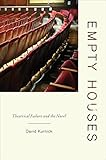Empty Houses : Theatrical Failure and the Novel / David Kurnick.
Material type: TextPublisher: Princeton, NJ : Princeton University Press, [2011]Copyright date: ©2012Edition: Core TextbookDescription: 1 online resource (272 p.) : 13 halftonesContent type:
TextPublisher: Princeton, NJ : Princeton University Press, [2011]Copyright date: ©2012Edition: Core TextbookDescription: 1 online resource (272 p.) : 13 halftonesContent type: - 9780691153162
- 9781400840090
- American fiction -- History and criticism
- Drama -- Technique -- History
- English fiction -- History and criticism
- Fiction -- Technique -- History
- LITERARY CRITICISM / General
- Daniel Deronda
- Exiles
- Felix Hold
- George Eliot
- Henry James
- James Baldwin
- James Joyce
- Lovel the Widower
- Middlemarch
- Romola
- The Awkward Age
- The Other House
- The Spanish Gypsy
- The Wolves in the Lamb
- Ulysses
- Vanity Fair
- William Makepeace Thackeray
- antitheatricality
- collective desire
- collective spaces
- collectivity
- drama
- dramanovels
- dramatic form
- epiphany
- interior monologue
- interiority
- literary criticism
- narrative voice
- novel
- novelists
- plays
- public space
- theater
- 823.009 23
- PR826
- online - DeGruyter
- Issued also in print.
| Item type | Current library | Call number | URL | Status | Notes | Barcode | |
|---|---|---|---|---|---|---|---|
 eBook
eBook
|
Biblioteca "Angelicum" Pont. Univ. S.Tommaso d'Aquino Nuvola online | online - DeGruyter (Browse shelf(Opens below)) | Online access | Not for loan (Accesso limitato) | Accesso per gli utenti autorizzati / Access for authorized users | (dgr)9781400840090 |
Browsing Biblioteca "Angelicum" Pont. Univ. S.Tommaso d'Aquino shelves, Shelving location: Nuvola online Close shelf browser (Hides shelf browser)

|

|

|

|

|

|

|
||
| online - DeGruyter Founding Gods, Inventing Nations : Conquest and Culture Myths from Antiquity to Islam / | online - DeGruyter Victorian Culture and Classical Antiquity : Art, Opera, Fiction, and the Proclamation of Modernity / | online - DeGruyter The Things Things Say / | online - DeGruyter Empty Houses : Theatrical Failure and the Novel / | online - DeGruyter Hamlet's Arab Journey : Shakespeare's Prince and Nasser's Ghost / | online - DeGruyter Slavery and the Culture of Taste / | online - DeGruyter The Selected Letters of Nikos Kazantzakis / |
Frontmatter -- Contents -- Acknowledgments -- Introduction -- One: Acoustics in the Thackeray Theater -- Two: George Eliot's Lot -- Three: Henry James's Awkward Stage -- Four: Joyce Unperformed -- Epilogue -- Notes -- Index
restricted access online access with authorization star
http://purl.org/coar/access_right/c_16ec
According to the dominant tradition of literary criticism, the novel is the form par excellence of the private individual. Empty Houses challenges this consensus by reexamining the genre's development from the mid-nineteenth to the mid-twentieth century and exploring what has until now seemed an anomaly--the frustrated theatrical ambitions of major novelists. Offering new interpretations of the careers of William Makepeace Thackeray, George Eliot, Henry James, James Joyce, and James Baldwin--writers known for mapping ever-narrower interior geographies--this book argues that the genre's inward-looking tendency has been misunderstood. Delving into the critical role of the theater in the origins of the novel of interiority, David Kurnick reinterprets the novel as a record of dissatisfaction with inwardness and an injunction to rethink human identity in radically collective and social terms. Exploring neglected texts in order to reread canonical ones, Kurnick shows that the theatrical ambitions of major novelists had crucial formal and ideological effects on their masterworks. Investigating a key stretch of each of these novelistic careers, he establishes the theatrical genealogy of some of the signal techniques of narrative interiority. In the process he illustrates how the novel is marked by a hunger for palpable collectivity, and argues that the genre's discontents have been a shaping force in its evolution. A groundbreaking rereading of the novel, Empty Houses provides new ways to consider the novelistic imagination.
Issued also in print.
Mode of access: Internet via World Wide Web.
In English.
Description based on online resource; title from PDF title page (publisher's Web site, viewed 29. Jul 2021)


